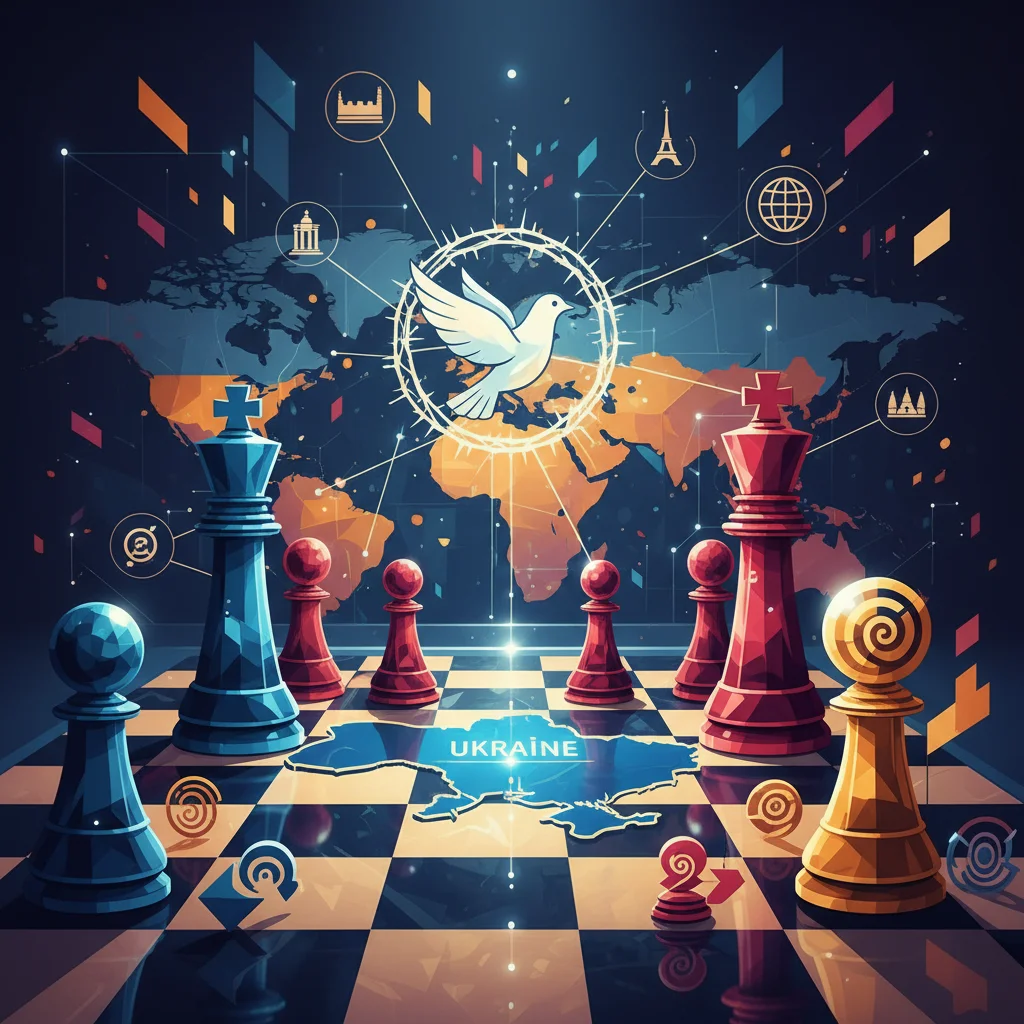
The High-Stakes Chess Game: Decoding the Global Scramble for a Ukraine Peace Deal
The Diplomatic Frontline: Navigating the Complex Path to Peace in Ukraine
As the war in Ukraine continues to reshape the global geopolitical and economic landscape, a parallel battle is being waged on the diplomatic front. A complex and increasingly crowded field of international actors is vying to broker a peace deal, each with its own agenda, motivations, and definition of “peace.” This intricate dance involves not only the traditional Western powers but also emerging global players, creating a multi-polar scramble for influence. For investors, business leaders, and anyone engaged in the global economy, understanding the nuances of these negotiations is critical. The outcome will not only determine the future of Ukraine but also send shockwaves through the stock market, energy prices, and international finance for years to come.
The central challenge lies in bridging the vast chasm between Ukraine’s non-negotiable demands for territorial integrity and Russia’s entrenched positions. Into this deadlock have stepped nations from the “Global South,” most notably China and Brazil, attempting to position themselves as neutral arbiters. However, their proposals have been met with skepticism from the West, which questions their neutrality and strategic motivations. This high-stakes chess game is less about a simple resolution and more about the future architecture of global power and its impact on international trading and banking systems.
The Rise of the Alternative Peacemakers: A New World Order?
For decades, global conflict resolution was largely the domain of the United States and its European allies. The war in Ukraine has highlighted a significant shift. Leaders like Brazil’s President Luiz Inácio Lula da Silva are actively courting a “peace club” of non-aligned nations to mediate. Lula’s trips to Beijing and his outspoken criticism of Western military support for Ukraine signal a clear ambition to offer an alternative to the G7-led world order. His administration has argued that arming Ukraine only prolongs the conflict, a stance that has caused friction with both Washington and Kyiv.
According to Michael Stott, the FT’s Latin America editor, Lula’s position is driven by a long-held Brazilian foreign policy of non-intervention and a desire to reclaim a prominent role on the world stage (source). While his intentions may be rooted in a genuine desire for peace, his suggestion that Ukraine might need to cede Crimea to achieve it was met with immediate and forceful rejection from Kyiv, highlighting the immense difficulty of finding common ground.
China’s involvement is even more consequential. As Russia’s most powerful economic and political partner, Beijing’s 12-point peace plan was initially seen as a potential breakthrough. However, its refusal to condemn the invasion and its close ties to Moscow have led many in the West to view its proposal as a strategic move to bolster Russia and undermine US influence rather than a credible path to peace. The plan’s vague language, calling for sovereignty to be respected while also urging an end to “unilateral sanctions,” is seen by critics as an attempt to have it both ways.
The 5 Business Crises Shaping Tomorrow's Leaders: What Top Professors Are Teaching Now
A Tale of Three Plans: Comparing the Paths to Peace
The diplomatic table is crowded with competing visions for ending the war. Each proposal reflects the strategic interests of its proponents, with significant differences in their approach to territory, sanctions, and security. Here is a comparative overview of the key peace frameworks being discussed:
| Peace Proposal | Key Proponent(s) | Core Principles | Stance on Territory | View on Sanctions & Military Aid |
|---|---|---|---|---|
| Ukraine’s 10-Point Peace Formula | Ukraine (President Zelenskyy) | Full withdrawal of Russian troops, restoration of Ukraine’s territorial integrity, accountability for war crimes, and long-term security guarantees. | Non-negotiable. Demands return to 1991 borders, including Crimea and all of the Donbas. | Demands continued and strengthened sanctions on Russia; requires ongoing military and financial support from the West. |
| China’s 12-Point Position Paper | China | Calls for a ceasefire, respect for sovereignty (without naming the aggressor), and an end to the “Cold War mentality.” | Vague. Does not explicitly call for Russian withdrawal from occupied Ukrainian territories. | Opposes “unilateral sanctions” and criticizes the expansion of military blocs, a clear reference to NATO. |
| Brazil’s “Peace Club” Concept | Brazil (President Lula) | Advocates for a group of neutral countries to mediate. Emphasizes an immediate halt to fighting. | Suggests compromise may be necessary. Lula has publicly floated the idea of Ukraine ceding Crimea (source). | Critical of Western nations supplying weapons to Ukraine, arguing it perpetuates the conflict. |
The Economic Battlefield: Sanctions, Finance, and the Cost of War
Beyond the diplomatic maneuvering, the economic dimension of the conflict is a critical battleground. The unprecedented sanctions imposed on Russia by the West were designed to cripple its war machine by cutting it off from the global finance and banking system. While these measures have inflicted significant damage, Russia’s economy has proven more resilient than initially expected, partly due to high energy prices and a pivot in trading relationships towards Asia.
This economic warfare has profound implications for the future of globalization. We are witnessing an accelerated fragmentation of the global financial system. Countries wary of Western sanctions are exploring alternatives to the US dollar for international trade and reserves. This trend could see a greater role for digital currencies and new financial technology (fintech) platforms designed to operate outside the traditional SWIFT system. Some analysts even speculate that blockchain technology could be leveraged to create sanctions-resistant payment channels, representing both a challenge and an opportunity for the global fintech industry.
For investors, the key takeaway is the heightened risk of economic balkanization. A company’s exposure to geopolitical fault lines is now a primary consideration for risk management. The war has demonstrated how quickly supply chains can be rerouted, energy markets can be upended, and access to capital can be weaponized. As Lee Harris of the FT noted, the West’s goal is to ensure Ukraine is in the strongest possible position before any negotiations begin, which means the economic pressure on Russia is unlikely to relent soon (source). This sustained economic conflict will continue to be a major driver of volatility in the stock market and global commodity prices.
The Unbridgeable Gaps: Territory, Security, and Justice
Ultimately, the success of any peace plan hinges on resolving a few core, seemingly intractable issues. The most significant is territory. Ukraine is resolute that peace is impossible without the full restoration of its 1991 borders. For Russia, relinquishing Crimea, which it annexed in 2014 and considers its own territory, is a political impossibility for the current regime. This fundamental disagreement remains the largest single obstacle to a ceasefire, let alone a lasting peace treaty.
Secondly, the question of security guarantees is paramount for Kyiv. After the failure of the 1994 Budapest Memorandum, under which Ukraine gave up its nuclear arsenal in exchange for security assurances, Kyiv will not accept vague promises. It seeks concrete, legally binding security guarantees from a coalition of major powers, akin to NATO’s Article 5. This is a red line for Moscow, which launched its full-scale invasion precisely to prevent Ukraine’s further integration with Western military structures.
Finally, there is the matter of justice. Ukraine and its allies are adamant that there must be accountability for war crimes and that Russia must pay reparations for the immense destruction it has caused. This is a non-starter for Russia and is largely absent from the peace proposals put forth by China and Brazil, which prioritize a swift end to hostilities over a justice and reconciliation process.
The £20 Million Question: Why Do High-Finance Professionals Need So Much to Retire?
Conclusion: An Unstable Equilibrium and the Road Ahead
The scramble for a Ukraine peace deal is a microcosm of a world in transition. The path to a sustainable resolution remains elusive, blocked by irreconcilable positions on territory and security. The well-intentioned but strategically fraught peace initiatives from nations like Brazil and China highlight the growing influence of the Global South but also underscore the deep divisions in how the world views the conflict.
For the foreseeable future, the world must prepare for a prolonged period of an unstable equilibrium. The conflict will continue to shape global economics, influencing everything from inflation and interest rates to investment flows and the development of new financial technology. Business leaders and investors must bake this heightened geopolitical risk into their long-term strategies, focusing on resilience, diversification, and a keen understanding of the shifting global power dynamics. The diplomatic chess game continues, and every move will have a tangible impact on the global market.


